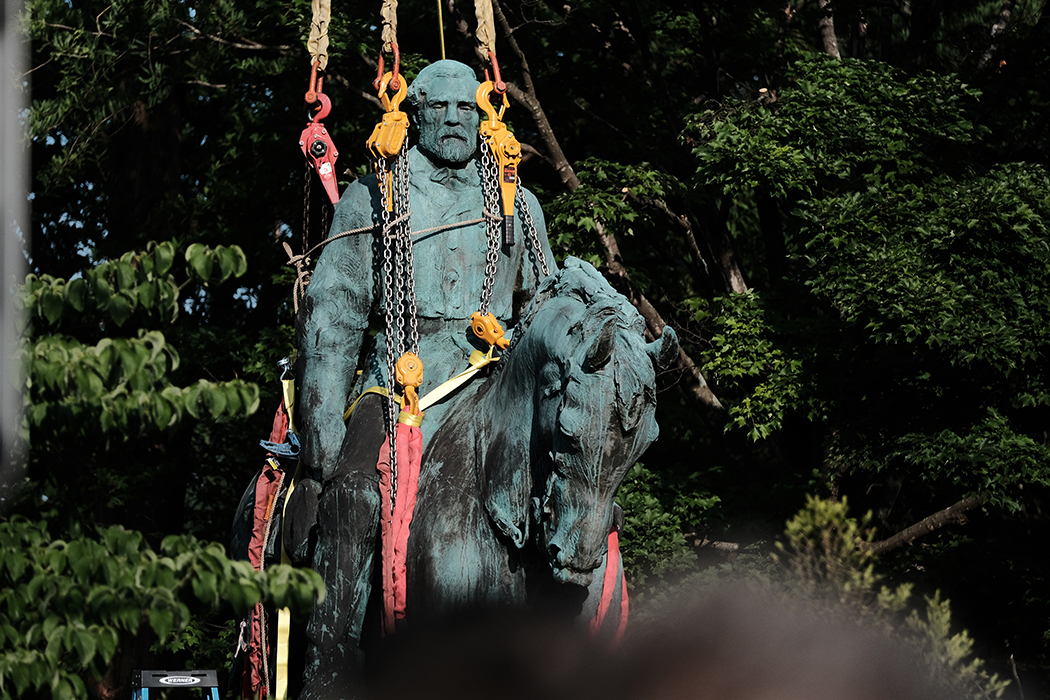Charlottesville finally removed its statues of Confederate generals Robert E. Lee and Stonewall Jackson in July. Since then, the spaces where the racist monuments once stood have been empty, as the city decides what should go there.
During a virtual forum hosted by the UVA Democracy Initiative’s Memory Project last week, Black activists Bree Newsome Bass and Emil Little shared their experiences confronting Confederate monuments, and discussed how public spaces like the ones in Charlottesville should be treated after the Confederate iconography is removed. Atlantic columnist and poet Clint Smith moderated the event.
After 21-year-old white supremacist Dylann Roof shot and killed nine Black people at a church in Charleston, South Carolina, in 2015, the state lowered its American flag atop the capitol to half-staff to honor the victims—but kept its Confederate flag flying high. Due to state law, the rebel flag could only be lowered after a two-thirds approval by the state legislature.
Instead of waiting for legislators to “essentially decide that our lives matter,” Newsome Bass felt she needed to take action and show defiance against white terrorism. Ten days after the horrific shooting, she scaled the flagpole outside the state capitol, and tore down the Confederate flag. She was immediately arrested.
“So much of the national focus of discussion was on the display of the flag, not the circumstances that led to a white man in his 20s being so errantly racist that he decides to go into a church and murder people,” said Newsome Bass. “It highlighted the disregard for our lives as Black people.”
The next month, South Carolina finally removed the Confederate flag from statehouse grounds—something Black activists had called for for decades.
Following the deadly Unite the Right rally in Charlottesville in 2017, students at the University of North Carolina held their own protest against the university’s Silent Sam statue, which commemorated a Confederate soldier. For months, white supremacists had been visiting the racist monument, causing many Black students to feel unsafe, explained Little.
“I’m thinking the school’s going to have our back on this,” said Little, who was a doctoral student at the university. “But I’m watching police shove students, laughing at them, mocking them, hitting them.”
Over the next year, Little participated in sit-ins in front of Silent Sam, and passed out materials about the racist history of the monument. Fed up with the university’s refusal to take action, Little smeared red ink—mixed with their own blood—onto the statue during a protest in 2018. Little was arrested and later found guilty of vandalism.
“If you’re so proud to have this armed solider still standing for this cause, why not depict what he stood for, which was the murder of Black people and their enslavement,” said Little.
Little was inspired to smear real blood on the statue by a protest they witnessed while studying in China, during which migrant workers threw blood on a police station.
“The next day, even though there was no blood, people were like, ‘This has been tainted.’ They wanted to avoid it,” said Little. “I knew that doing [my protest] during the day meant that people would see the red ink and blood…and we believe that when something is bloodied it’s tainted.”
Four months later, hundreds of student protesters toppled Silent Sam. A tree has since been planted at the former site of the statue.
When recontextualizing the spaces where Confederate monuments once stood, Newsome Bass said it’s important to go “a step beyond” replacing them with a statue of a Black historical figure, like Harriet Tubman.
“It has often been about idealizing particular figures, which goes to the way that society itself is organized around capitalistic ideas of individualism, white patriarchy, the idea that we have supreme white men that are elevated above the rest of humanity,” said Newsome Bass.
“How do we transform public space in a way that honors and celebrates the ideals of humanity or the inclusion of everyone?” she asked.
Little wishes the Silent Sam monument had been left, toppled, on the ground. “UNC getting rid of it was convenient,” Little said. “Not only did the monument disappear, but the history of contention around the monument disappeared when it was taken away.”
For people like the Sons of Confederate Veterans, Confederate spaces are sacred because of their family lineage and belief in the Lost Cause myth, Smith pointed out. “How are you thinking about what it means to…make clear that these things that are rendered holy are manifestations of harm?”
Newsome Bass said she classifies white supremacy as a religion, upheld by centuries of colonization and state-sponsored violence.
“One of the main ways we desacralize something is to name it and classify it as a thing,” she said. “When we are talking about taking down a monument, it’s never just about the monument—it’s about the deconstruction of this ideology of whiteness.”
Both activists encouraged the audience to educate themselves on white supremacy, and support activists and organizers fighting for Black liberation.
“You cannot enter into this kind of a thing without taking a side,” Little said. “To be an observer in a struggle for life and death for Black people to me means you’re already against me.”
























